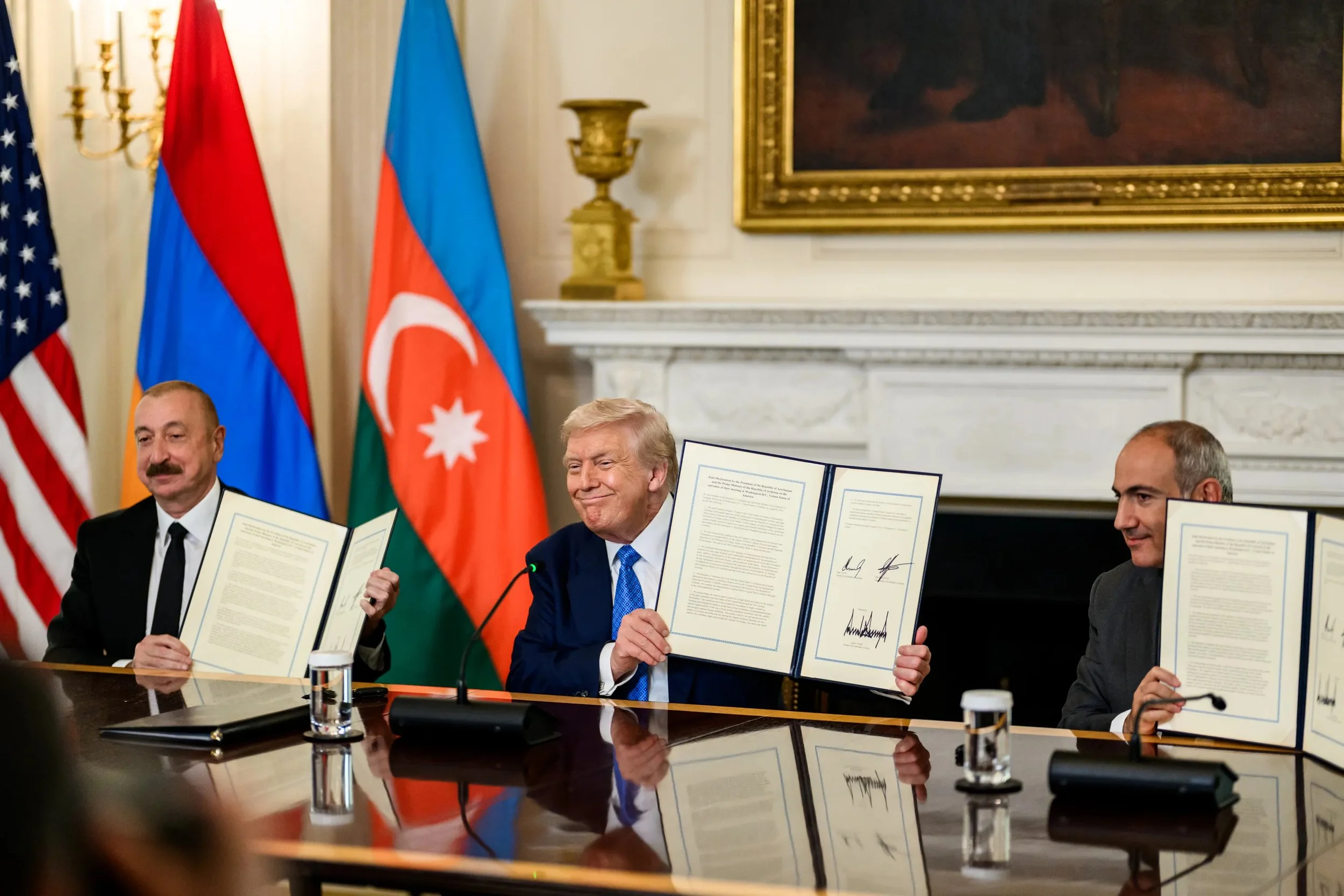President Trump Brokers Historic Peace Deal Between Armenia and Azerbaijan
Pictured are President Aliyev (left), President Trump (center), and President Pashinyan (right). Photo from The White House. CC-BY 3.0
The Road to Peace
On Friday, August 8, 2025, leaders from Armenia and Azerbaijan signed a historic joint declaration at the White House, a monumental step toward resolving the two countries’ long-standing and often violent conflict. The agreement, hailed as a significant breakthrough, also serves as a diplomatic victory for President Donald Trump, further cementing his international influence in peace negotiations.
A major element of the agreement is Armenia’s commitment to granting the United States exclusive development rights for a vital transit corridor through its territory. This corridor will connect Azerbaijan, situated to the east of Armenia, to Nakhichevan—an Azerbaijani enclave located on Armenia's western border and its sole land connection with Turkey, a key ally of Azerbaijan. The 27-mile route, named the Trump Route for International Peace and Prosperity, will run along Armenia’s southern border with Iran, a strategically important area that has been a flashpoint in the region.
The naming of the corridor was part of an effort to solidify President Trump's role in the peace process.
In open pursuit of a Nobel Peace Prize, Mr. Trump has involved himself in peace negotiations between Cambodia and Thailand; the military conflict between Israel and Iran; and tensions between India and Pakistan.
Historical Conflict
The conflict between Azerbaijan and Armenia has spanned more than three decades, fueled by deep ethnic and territorial disputes. The Nagorno-Karabakh region, an area populated mostly by ethnic Armenians, has been the epicenter of violence since 1988, when the final years of the USSR saw ethnic tensions erupt into a brutal conflict. This escalated further with Azerbaijan’s offensive against Nagorno-Karabakh in the early 1990s, leading to over 30,000 deaths. Another deadly round of fighting occurred in 2020, during which at least 6,000 people lost their lives in just 44 days.
Despite the historic nature of the peace deal between Armenia and Azerbaijan, critics have expressed skepticism due to the lack of legal binding agreements within the accord. They argue that without enforceable terms, the deal may lack the necessary mechanisms for long-term stability. However, the significance of the agreement cannot be understated, as it marks a rare moment where both leaders were able to sit down together, engage in dialogue, and, notably, shake hands. This symbolic gesture of reconciliation is seen as a crucial first step, showcasing President Trump’s ability to bring two long-time adversaries to the table and initiate a diplomatic breakthrough, even if the deal itself lacks legal guarantees. The meeting itself demonstrates a willingness for peace, which, in the context of decades of conflict, is a pivotal development.
Source: Squarespace/ Unsplash
Leaders' Statements on the Agreement
The agreement was celebrated by all parties involved. In his address, President Trump emphasized the importance of the deal, stating, “For more than 35 years, Armenia and Azerbaijan have fought a bitter conflict that resulted in tremendous suffering for both nations… Many tried to find a resolution… and they were unsuccessful. With this Accord, we’ve finally succeeded in making peace.”
Azerbaijani President Aliyev expressed his nation’s gratitude toward President Trump, noting, “It’s a day which will be remembered by the people of Azerbaijan with a feeling of pride and gratitude to President Trump… Within several months, he managed to put an end to conflicts in Asia, in Africa, and now in South Caucasus — what we could not achieve for more than 30 years… We will turn the page of standoff, confrontation, and bloodshed, and provide a bright and safe future for our children.”
Prime Minister Pashinyan of Armenia also praised the deal, saying, “Today, we have reached a significant milestone in Armenian and Azerbaijani relations. We are laying a foundation to write a better story than the one we had in the past. This breakthrough would simply not have been possible without President Trump’s personal engagement and his resolute commitment to peace.”
The Future of Peace in the South Caucasus
The signing of this peace agreement marks a new chapter for Armenia and Azerbaijan. While challenges remain, the Trump Route symbolizes hope for a region once embroiled in continuous conflict. The U.S.'s involvement in facilitating this deal is a testament to its role as a global peacemaker, with President Trump’s active participation driving the negotiations to a successful conclusion.
As both countries look toward the future, this deal not only promises improved relations between Azerbaijan and Armenia but also sets the stage for potential stability in the wider South Caucasus region.



